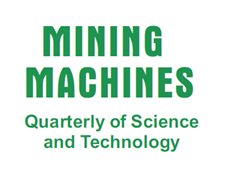- Simulation of air-water mist propagation in spraying system
CHUCHNOWSKI W., TOKARCZYK J. - Impact of design features of the leg on yield characteristics of powered roof support
JASZCZUK M., PAWLIKOWSKI A. - Virtual prototyping of roadheader control system
JSIULEK D., ŚWIDER J. - New KOMAG pulsation water jigs in installations for hard coal and mineral aggregates processing
OSOBA D. - Control system for KOMAG jig
TEJSZERSKI J., JASIULEK D., PAJĄK T. OSOBA M. - Model of dust pollutants propagation and environmental measurements – comparison on the example of Lodz city
LOSTER A. - Control system for KOMAG jig
TEJSZERSKI J., JASIULEK D., PAJĄK T. OSOBA M. - Scenarios of development of mechanization technology in the mining industry till 2020 according to experts’ opinion
KOZIEŁ A., MAZURKIEWICZ T.
Simulation of air-water mist propagation in spraying system
CHUCHNOWSKI W., TOKARCZYK J.
The method of modelling air-water stream of spraying nozzles was presented in the paper. Computational Fluid Dynamics (CFD) method was used for calculations. Geometrical model of nozzles was made in Autodesk Inventor and calculation were made in Fluent Software. The model of multi-phase flow (water + air) was solved using Euler – Lagrange method. Verification of numerical models with stand tests was presented.
Impact of design features of the leg on yield characteristics of powered roof support
JASZCZUK M., PAWLIKOWSKI A.
The method of determination of two-telescopic hydraulic leg elasticity was presented. Impact of leg design features on its characteristics with consideration of three variants of technical solutions was analyzed. Yield characteristics of powered roof support with two-telescopic legs was determined in a result of computer simulation of kinematic force of canopy movement. Analysis was carried out for a flat model of powered roof support for different setting loads.
Virtual prototyping of roadheader control system
JSIULEK D., ŚWIDER J.
Implementation of intelligent roadheader control system is associated with a necessity of long and expensive tests. New approach consisting in use of virtual prototyping, which will be then coupled with a real PLC controller, will be applied to limit maximally cost and time of system implementation. Virtual model of road header operational area will enable, among others, to include the changes of properties of cut rock and simulation of machine reaction. Simulation tests, carried out on the model, will enable an effective verification and correction of algorithm and control software what can reduce time of implementation of the control system in a real machine.
New KOMAG pulsation water jigs in installations for hard coal and mineral aggregates processing
OSOBA D.
New applications of KOMAG pulsation water jigs for hard coal and mineral aggregates processing were presented in the paper. Possibilities of their cooperation with the control systems of different manufacturers were described. Their technical parameters were given. Results of tests of jig’s operation, which separates organic impurities from gravel-an-sand feed in conditions of minerals aggregates mine, were discussed
Control system for KOMAG jig
TEJSZERSKI J., JASIULEK D., PAJĄK T. OSOBA M.
KOMAG specialists, having experience and know- ledge to design pulsating jigs and knowledge in selection of operational parameters of these machines, have developed an author’s control system to control the pulsation jig. The project included a development of configuration of system’s hardware, its control algorithm as well as building of control system based on PLC controller. Testing of the system on the laboratory model of pulsation jig was carried out in the KOMAG Centre and industrial tests carried out on the selected jig have started in mid of 2007 in the Processing Plant of Pniowek Colliery. Structure of the system, operational principles and possibilities of the system as well as test results with conclusions were given.
Model of dust pollutants propagation and environmental measurements – comparison on the example of Lodz city
LOSTER A.
Modelling of processes of propagation and changes of pollutants in the atmosphere plays a significant role both in assessment of present condition and development and implementation of repair and preventive investigations. A short characteristic of measuring method, which was used for calculations of propagation of dust pollutants, was presented in the first part of the paper. The second part of the paper includes basic assumptions and results of model tests, which were carried out on the example of Lodz city. Obtained results were compared with concentrations of PM10 dust obtained during environmental measurements.
Scenarios of development of mechanization technology in the mining industry till 2020 according to experts’ opinion
KOZIEŁ A., MAZURKIEWICZ T.
Results of assessment, made by Delphi method, of scenarios of development of mechanization technology in the mining industry were presented in the paper. The above mentioned problem is realized within a targeted project of a foresight type entitled: “Scenarios of technological development of hard coal mining industry”, which is coordinated by Central Mining Institute in Katowice in cooperation with AGH University of Science and Technology in Cracow, IGSMiE PAN in Cracow, Silesian University of Technology in Gliwice, EMAG in Katowice and KOMAG Mining Mechanization Centre in Gliwice. Presented assessment results enable to determine a hierarchy of mechanization technology, stages of predicted implementation and priority directions of scientific-and-research work, which enables to reach the set objectives.






 Badanie bezpieczeństwa wyrobów
Badanie bezpieczeństwa wyrobów Klaster Maszyn Górniczych
Klaster Maszyn Górniczych